Related Research Articles
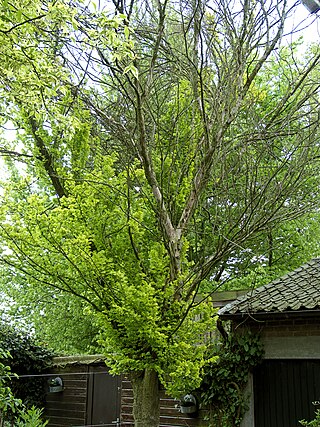
Dutch elm disease (DED) is caused by a member of the sac fungi (Ascomycota) affecting elm trees, and is spread by elm bark beetles. Although believed to be originally native to Asia, the disease was accidentally introduced into America, Europe, and New Zealand. In these regions it has devastated native populations of elms that did not have resistance to the disease. The name "Dutch elm disease" refers to its identification in 1921 and later in the Netherlands by Dutch phytopathologists Bea Schwarz and Christine Buisman, who both worked with professor Johanna Westerdijk. The disease affects species in the genera Ulmus and Zelkova, therefore it is not specific to the Dutch elm hybrid.
Ambrosia beetles are beetles of the weevil subfamilies Scolytinae and Platypodinae, which live in nutritional symbiosis with ambrosia fungi. The beetles excavate tunnels in dead, stressed, and healthy trees in which they cultivate fungal gardens, their sole source of nutrition. After landing on a suitable tree, an ambrosia beetle excavates a tunnel in which it releases spores of its fungal symbiont. The fungus penetrates the plant's xylem tissue, extracts nutrients from it, and concentrates the nutrients on and near the surface of the beetle gallery. Ambrosia fungi are typically poor wood degraders, and instead utilize less demanding nutrients. Symbiotic fungi produce and detoxify ethanol, which is an attractant for Ambrosia beetles and likely prevents growth of antagonistic pathogens and selects for other beneficial symbionts. The majority of ambrosia beetles colonize xylem of recently dead trees, but some attack stressed trees that are still alive, and a few species attack healthy trees. Species differ in their preference for different parts of trees, different stages of deterioration, and in the shape of their tunnels ("galleries"). However, the majority of ambrosia beetles are not specialized to any taxonomic group of hosts, unlike most phytophagous organisms including the closely related bark beetles. One species of ambrosia beetle, Austroplatypus incompertus exhibits eusociality, one of the few organisms outside of Hymenoptera and Isoptera to do so.

A bark beetle is the common name for the subfamily of beetles Scolytinae. Previously, this was considered a distinct family (Scolytidae), but is now understood to be a specialized clade of the "true weevil" family (Curculionidae). Although the term "bark beetle" refers to the fact that many species feed in the inner bark (phloem) layer of trees, the subfamily also has many species with other lifestyles, including some that bore into wood, feed in fruit and seeds, or tunnel into herbaceous plants. Well-known species are members of the type genus Scolytus, namely the European elm bark beetle S. multistriatus and the large elm bark beetle S. scolytus, which like the American elm bark beetle Hylurgopinus rufipes, transmit Dutch elm disease fungi (Ophiostoma). The mountain pine beetle Dendroctonus ponderosae, southern pine beetle Dendroctonus frontalis, and their near relatives are major pests of conifer forests in North America. A similarly aggressive species in Europe is the spruce ips Ips typographus. A tiny bark beetle, the coffee berry borer, Hypothenemus hampei is a major pest on coffee plantations around the world.

Oak wilt is a fungal disease caused by the organism Bretziella fagacearum that threatens Quercus spp. The disease is limited to the eastern half of the United States; first described in the 1940s in the Upper Mississippi River Valley. The pathogen penetrates xylem tissue, preventing water transport and causing disease symptoms. Symptoms generally consist of leaf discoloration, wilt, defoliation, and death. The disease is dispersed by insect vectors and to adjacent trees through underground root networks. However, human spread is the most consequential dispersal method. Moving firewood long distances can potentially transport diseases and invasive species.

Verticillium wilt is a wilt disease affecting over 350 species of eudicot plants. It is caused by six species of Verticillium fungi: V. dahliae, V. albo-atrum, V. longisporum, V. nubilum, V. theobromae and V. tricorpus. Many economically important plants are susceptible including cotton, tomatoes, potatoes, oilseed rape, eggplants, peppers and ornamentals, as well as others in natural vegetation communities. Many eudicot species and cultivars are resistant to the disease and all monocots, gymnosperms and ferns are immune.

Ophiostoma ulmi is a species of fungus in the family Ophiostomataceae. It is one of the causative agents of Dutch elm disease. It was first described under the name Graphium ulmi, and later transferred to the genus Ophiostoma.
Ophiostoma novo-ulmi is a species of fungus in the family Ophiostomataceae. It is one of the key causative agents associated with Dutch Elm Disease (DED), along with Ophiostoma ulmi and Ophiostoma himal-ulmi.

Bursaphelenchus xylophilus, commonly known as pine wood nematode or pine wilt nematode (PWN), is a species of nematode that infects trees in the Pinus genus of coniferous trees and causes the disease pine wilt. While native to North America, it spread in the early 20th century to Japan and in the latter half of the century to other areas of Asia, including China, Taiwan, and Korea, as well as to Europe, including Portugal and Spain.
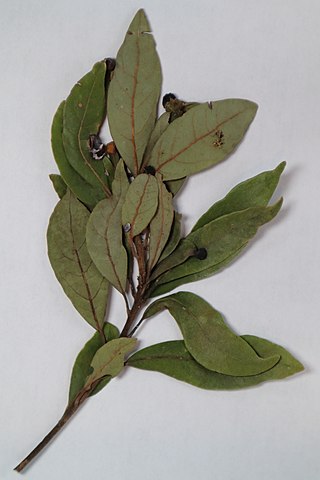
Laurel wilt, also called laurel wilt disease, is a vascular disease that is caused by the fungus Raffaelea lauricola, which is transmitted by the invasive redbay ambrosia beetle, Xyleborus glabratus. The disease affects and kills members of the laurel family. The avocado is perhaps the most commercially valuable plant affected by laurel wilt.
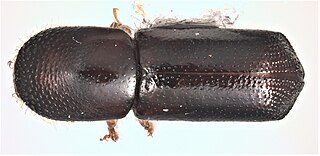
Xyleborus glabratus, the redbay ambrosia beetle, is a type of ambrosia beetle invasive in the United States. It has been documented as the primary vector of Raffaelea lauricola, the fungus that causes laurel wilt, a disease that can kill several North American tree species in the family Lauraceae, including redbay, sassafras, and avocado.
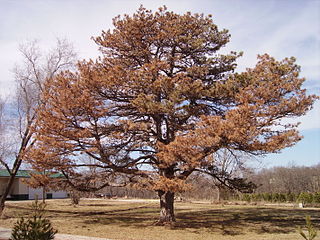
A wilt disease is any number of diseases that affect the vascular system of plants. Attacks by fungi, bacteria, and nematodes can cause rapid killing of plants, large tree branches or even entire trees.
Forest pathology is the research of both biotic and abiotic maladies affecting the health of a forest ecosystem, primarily fungal pathogens and their insect vectors. It is a subfield of forestry and plant pathology.
Raffaelea quercivora is a species of fungus in the family Ophiostomataceae. It causes Japanese oak wilt disease, and is spread by the ambrosia beetle. It has small obovoid to pyriform sympodioconidia and slender, long conidiophores. The fungus has been isolated from the body surfaces and mycangia of the beetle.
The foamy bark canker is a disease affecting oak trees in California caused by the fungus Geosmithia pallida and spread by the Western oak bark beetle. This disease is only seen through the symbiosis of the bark beetles and the fungal pathogen. The bark beetles target oak trees and bore holes through the peridermal tissues, making tunnels within the phloem. The fungal spores are brought into these tunnels by the beetles and begin to colonize the damaged cells inside the tunnels. Symptoms of the developing fungus include wet discoloration seeping from the beetle entry holes as the fungus begins to consume phloem and likely other tissues. If bark is removed, necrosis of the phloem can be observed surrounding the entry hole(s). As the disease progresses, a reddish sap and foamy liquid oozes from entry holes, thus giving the disease the name foamy bark canker. Eventually, after the disease has progressed, the tree dies. This disease is important because of its detrimental effects on oak trees and its ability to spread to several new Californian counties in just a couple of years.
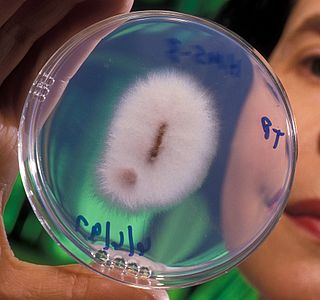
Koa wilt is a relatively new disease to Hawaii, discovered in 1980. Koa wilt is caused by a forma specialis of the fungus Fusarium oxysporum, which is now abundant in Hawaiian soils and infects the native Acacia koa tree, a once-dominant species in the canopy of Hawaiian forests. Fusarium oxysporum f.sp. koae is believed to have been brought into Hawaii on an ornamental acacia plant. Fusarium fungi clog the tree xylem, causing significant wilt and mortality among these beautiful and iconic Hawaiian trees.

Species which are not native to a forest ecosystem can act as an agent of disturbance, changing forest dynamics as they invade and spread. Invasive insects and pathogens (diseases) are introduced to the United States through international trade, and spread through means of natural and human-dispersal. Invasive insects and pathogens are a serious threat to many forests in the United States and have decimated populations of several tree species, including American chestnut, American elm, eastern hemlock, whitebark pine, and the native ash species. The loss of these tree species is typically rapid with both short and long-term impacts to the forest ecosystem.
Platypus quercivorus, the oak ambrosia beetle, is a species of weevil and pest of broad-leaved trees. This species is most commonly known for vectoring the fungus responsible for excessive oak dieback in Japan since the 1980s. It is found in Japan, India, Indonesia, New Guinea, and Taiwan.

Arrenodes minutus, commonly known as the oak timberworm, is a species of primitive weevil in the family Brentidae. These beetles are pests of hardwoods in North America. Adult oak timberworms are shiny, elongate, and range 7 to 25 mm in length. They are reddish-brown to brownish-black in coloration, with yellow spots on their elytra. Adults display strong sexual dimorphism; females have long, slender, straight mouthparts, while males possess flattened, broadened mouthparts with large mandibles. Males are known to be aggressive and use these large mandibles for combat. These mandibles are also used in courtship. Larvae are elongate, cylindrical, white, and curved. They have 3 pairs of jointed legs on the thorax and 1 pair of prolegs near the end of the abdomen.
Euwallacea interjectus, is a species of weevil native to Asia but introduced to Westerns parts of the world.

Xyleborus monographus, the Mediterranean oak borer, is a species of ambrosia beetle in the family Curculionidae. It is native to oaks in the regions around the Mediterranean Sea, but since 2019 has been found in California, where the oak trees it infests may be more vulnerable.
References
- ↑ Ito S., Kubono T., Sahasi N., Yamada T.(1998)Associated fungi with the mass mortality of oak trees. Journal of the Japanese Forestry Society 80(3), 170-175.
- 1 2 Kuroda, K.; Yamada, T. (1996). "Discoloration of sapwood and blockage of xylem sap ascent in the trunks of wilting Quercus spp. following attack by Platypus quercivorus". Journal of the Japanese Forestry Society. 78 (1): 84–88.